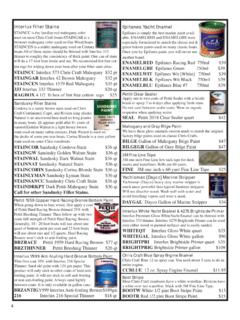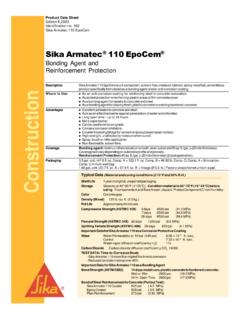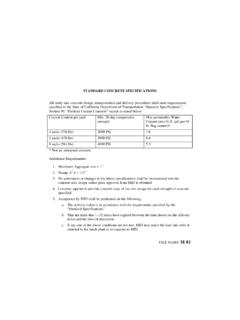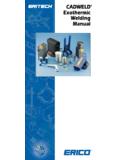Transcription of 09191 - FUNDAMENTALS OF BRISTLE BLASTING PROCESS …
1 2009 Copyright 2009 by NACE International. Requests for permission to publish this manuscript in any form, in part or in whole must be in writing to NACE International, Copyright Division, 1440 South creek Drive, Houston, Texas 777084. The material presented and the views expressed in this paper are solely those of the author(s) and are not necessarily endorsed by the Association. Printed in the 1 FUNDAMENTALS OF BRISTLE BLASTING PROCESS FOR REMOVING CORROSIVE LAYER Robert J. Stango, and Piyush Khullar Mechanical Engineering Department 1515 West Wisconsin Avenue Marquette University Milwaukee, WI 53233 USA ABSTRACT This technical paper introduces a newly developed surface preparation PROCESS termed BRISTLE BLASTING , which utilizes a specially designed rotary power tool for simultaneously removing corrosion and generating an anchor profile. The PROCESS derives its name from sharp, hardened BRISTLE tips which, upon striking the corroded surface, immediately retract, thereby creating a micro-indentation that both removes corrosion and simultaneously exposes fresh subsurface material.
2 Consequently, the repeated collision/retraction of BRISTLE tips with the corroded surface leads to a surface cleanliness and anchor profile that resembles surface prepared by grit BLASTING processes. Performance of the BRISTLE BLASTING PROCESS is evaluated within the context of an application that involves cleaning/texturing severely corroded API 5L piping, which is commonly used for onshore/offshore petroleum transport applications. The results demonstrate that surface cleanliness and texture achieved via BRISTLE BLASTING tools is on a par with grit BLASTING processes. That is, a near-white metal and white metal appearance of cleaned surfaces is routinely obtained, and is accompanied by an average peak-to-valley surface texture (Rz, microns) given by: 83 Rz 62. Finally, careful study indicates that BRISTLE BLASTING tools can remove corrosion at a rate in excess of one square meter per hour throughout the duration of tool life.
3 KEY WORDS BRISTLE Blast; Surface Cleaning; Surface Preparation; Removal of Corrosive Products; Corrosion Removal; Anchor Profile INTRODUCTION AND BACKGROUND Steel structures play a vital role in supporting the infrastructure of transportation, habitat, and the distribution of goods and natural resources. In order to safeguard and maintain this infrastructure, polymer chemists have formulated advanced paints and coatings that can protect surfaces from corrosion and prolong the life/integrity of steel components. Nevertheless, these coatings are subject to environmental attack and eventually deteriorate, thereby requiring partial or complete removal prior to the reapplication of fresh coating. This cycle of repair/refurbishment is an important part of infrastructure maintenance programs that is both costly and time consuming. To this end, grit BLASTING 1 Paper has emerged as the principal method for surface cleaning and preparation chiefly because the PROCESS satisfies several important criteria, namely: Both the defunct coating and corrosion are simultaneously removed, Surfaces can be restored to meet the required visual cleanliness standards, and Coarse surface roughness profiles can be achieved that are deemed necessary prior to the application of protective paints and coatings.
4 Although grit BLASTING is the most widely used method for preparing steel surfaces, maintenance engineers are constantly searching for new/alternative surface treatment processes that can circumvent many of the difficulties and shortcomings that are associated with this PROCESS . Most notably, for example, grit BLASTING is an expensive, cumbersome PROCESS that is neither environment nor user-friendly. The seriousness of health and safety issues has recently prompted the Environmental Protection Agency (USA) to propose national emission standards for controlling hazardous air pollutants associated with abrasive blasting1. At the same time, the Occupational Safety and Health Administration (USA) has recently issued directives that may have widespread implications on nearly all types of abrasive BLASTING processes/media2. Altogether, these concerns render the abrasive BLASTING PROCESS especially inefficient and poorly suited for applications involving local rehabilitation or spot-repair , wherein steel surfaces are in need of immediate repair due to paint delamination and/or severe corrosion.
5 In this paper, a new PROCESS termed BRISTLE BLASTING is introduced that utilizes a rotary power tool for simultaneously removing corrosion and generating an anchor profile. Although the BRISTLE BLASTING tool has an appearance that resembles wire brushes, the underlying principles of operation are shown to have little, if any, commonality with brushing processes. It is demonstrated that the BRISTLE BLASTING PROCESS is very closely related to the impact mechanics behavior that is typically associated with grit BLASTING processes. Performance of the BRISTLE BLASTING PROCESS is examined within the context of cleaning/profiling severely corroded API 5L steel piping; however, the tool can be readily used for applications involving shipyard repair and bridge refurbishment as well. The findings of this study show that the corrosion removal mechanics of the BRISTLE BLASTING PROCESS can be likened to that of grit BLASTING operations, and that the performance and reliability of BRISTLE BLASTING tools can be accurately forecasted over the duration of the tools service life.
6 REVIEW OF MEDIA/SURFACE INTERACTIONS In this section, impact mechanics and surface interactions that are characteristic of grit BLASTING processes and brushing processes is reviewed. This review will help establish common ground for kinetic and kinematic comparison between the two different processes, and will also provide an historical background that relates grit BLASTING and the newly developed BRISTLE BLASTING PROCESS . Grit BLASTING PROCESS Grit BLASTING is a free-impact surface treatment PROCESS that involves the controlled use of minute projectile particles of various size, composition, and hardness. The PROCESS is depicted in Figure 1, whereby media having mass mp undergoes free impact with target surface S. PROCESS parameters include the media pre-impact speed vp and arbitrary media entrance angle i, whereas the post-impact speed vf and exit angle f of the media is a consequence of the elastic-plastic interaction that characterizes the impact event.
7 On the basis of particle mechanics, the available kinetic energy e and working energy ep of the media, respectively, is written e = mpvp2 ; (1) ep = mpvp2 sin2 i (2) 23 FIGURE 1 - Pictorial representation of an FIGURE 2 - Basic types of the impact craters formed abrasive BLASTING PROCESS with an arbitrary during an abrasive BLASTING PROCESS (figures taken shaped grit. from Budinski, and Chin, (1983)) featuring pitting (Fig.)
8 2a), plowing ( ), shoveling ( ) and chipping ( ). where Eq. (2) presumes that the particle is unconstrained in the horizontal direction. As shown in Figure 1, the collision typically results in a pit or crater whose geometry is closely related to the shape of the propelled media. One of the earliest studies reported in the archival literature on grit BLASTING was published as recently as 1971, whereby researchers examined the role that grit blast processing parameters play in the modification of stainless steel surfaces3. Their work focused on examining the texture, dimensional change, and material removal performance of 100-mesh garnet used at a normal incident contact angle ( i = 90 ). Later, a pioneering investigation was conducted that examined the geometric nature of impact craters that are generated on various ductile metallic surfaces by single particle media comprised of 120 grit aluminum oxide4.
9 The authors were able to classify impact site features into the four basic categories shown in Figure 2, namely, pitting (Figure 2a), plowing (Figure 2b), shoveling (Figure 2c), and chipping (Figure 2d). Moreover, these impact features were found to be independent of both the composition and hardness of the substrate material. The author s conjectured that the evolution of texture and other features that characterize surface structure of grit BLASTING processes is a complex superposition of these fundamental impact signatures. Wire Brushing PROCESS Wire brushing processes involve repetitive contact of BRISTLE tips with a target surface. The PROCESS is shown in Figure 3, whereby bristles having length L and mass mb, are attached along the perimeter of a rotating hub having radius rh and angular velocity . As depicted in Figure 3, the BRISTLE /media is constrained at one end (namely, the hub) whereas the BRISTLE tip is free to undergo contact with the surface.
10 Generally, the forces exerted by the BRISTLE tip onto the surface can vary within the contact zone. On the basis of rigid body mechanics, the available kinetic energy of the rotating BRISTLE is equivalent to the working energy of the BRISTLE and can be written: eb = mbvG2 + IG 2 (3) where eb is the total kinetic energy of a BRISTLE that undergoes orthogonal impact with surface S, vG is the velocity of the mass center, and IG is the mass moment of inertia of the BRISTLE about mass center, G. Ordinarily, brush fabrication methods utilize fully populated, tightly packed bristles that exhibit considerable flexure during impact. Therefore, the collision/contact event between the BRISTLE tips and 34 FIGURE 3 - Planar view of wire brushing tool (lower portion only) illustrating BRISTLE tips in FIGURE 4 - Score markings or striations associated contact with the workpart surface, S.








